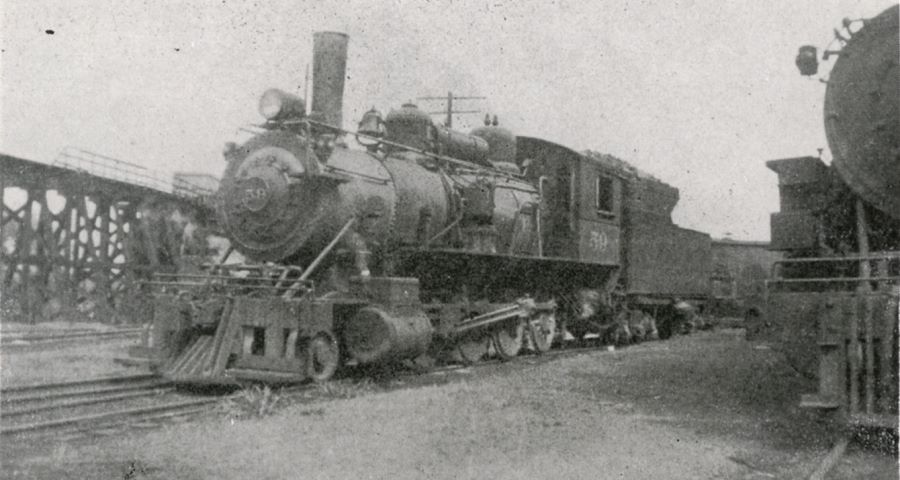-> My Collection; Magazine is not fully scanned, so no source album to see.
National Railway Historical Society
Third Quarter 1949, Volume XIV, No.3
(pages 25-27)
Copyright 1949 by National Railway Historical Society, Inc.
Text is slightly edited for glaring errors and some words added/rewritten.
 Pic Courtesy: R.H. Kindig
Pic Courtesy: R.H. KindigOn January 8, 1949, M.T. locomotives Nos. 64, 65, and 66, all 2-6-0's, head for Cripple Creek from Midland, Colo., with a train of 35 cars.
"The One Day Railroad Trip that Bankrupts the English Language"
This remark, attributed to President Theodore Roosevelt concerning his journey over the Midland Terminal Railroad Short Line, was once used as a slogan in the hey-dey of its passenger train service by that company. We had the pleasure of riding this colorful 55 mile line Aug. 8, 1936, in the eight passenger rebuilt trolley car equipped with dual Mack motors, and can testify to the beauty of the ride, especially near New Elkton, where the Sangre de Cristo, The Continental Divide, Harvard, Princeton and Yales peaks are clearly visible from the train, as is also Pikes Peak.
Now, the line is gone. The last freight train operated Feb. 18, 1949, passenger service having ceased in 1943.
July 4, 1894, saw the first slim-gauge passenger train pull into Cripple Creek over the newly built Florence and Cripple Creek Railroad using Rio Grande power and rolling stock. The Midland Terminal standard gauge line, was built into Cripple Creek in 1895, using the tracks of the Colorado Midland from Divide into Cripple Creek.
These two lines caused an immense mining boom in this section lasting into the Twentieth Century.
However, these lines came under the control of the "Denver and Southwestern Railroad" a holding company, and promptly raised rail rates. They also controlled the smelters at Colorado City and Florence. However, the mine owners were not content to pay unjust rates and they promptly began to operate the Cripple Creek District Railway, an interurban line running between Victor and Cripple Creek, known as the "high line".
Not content with one interurban, tThey also built another railroad, "The Colorado Springs and Cripple Creek District" also known as the "Short Line" in 1901, while another interurban, running between Victor and Cripple Creek, known as the "Low Line" was built. Freight rates dropped in a hurry, the mine owners being victorious.
However, all these lines gradually passed out of the picture thru mergers, flood damage and the like, except the Midland Terminal, which had bought part of the Colorado Midland in 1918, when that line was abandoned, from Colorado Springs to Divide.
 Pic Courtesy: J.H. Leath
Pic Courtesy: J.H. LeathM.T. No. 59, Low-wheeled Consolidation, was built by Schenectady in 1898. It was photo-graphed on the Midland Terminal in March, 1943.
During the twenties, the Midland Terminal operated one passenger train daily and necessary ore freights, but during the thirties, steam passenger operation gave way to gas powered rail cars, built from converted Colorado Springs trolley cars, one of which we had the pleasure of riding in 1936. In 1933, Cripple Creek enjoyed a new mining boom, which gave way during the Second World War, and post-war mining did not come up to expectations.
 Pic Courtesy: J.H. Leath
Pic Courtesy: J.H. LeathTypical of the last pass-enger equipment on the Midland Terminal, seen at Cripple Creek Depot, M.T. motor No. 101, a former street car with a rebuilt front end, and equipped with an internal combustion engine.
The Golden Cycle Corporation which owned the smelter at Colorado Springs and a number of mines in 1948 decided to move it to Cripple Creek which eliminated the need for the railroad which was sold to a Dallas Junk firm.
Two 2-8-2's were sold to the Mexico Northwestern and the three 2-6-0's and three 0-6-0's to the Norfolk and Portsmouth Belt Line, the fleet of Midland Terminal and Colorado Midland 2-8-0's having been previously scrapped.
L. R.F.
(L.R. Franks, Editor of the Bulletin ?)
(Grateful acknowledgement is made to the March 31, 1949 publication of the Rocky Mountain Railroad Club for information in above article)